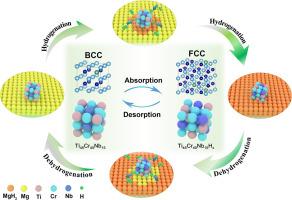熔体纺丝制备的TiCrNb氢化物作为提高MgH2储氢性能的有效催化剂
IF 13.8
1区 材料科学
Q1 METALLURGY & METALLURGICAL ENGINEERING
引用次数: 0
摘要
氢化镁(MgH2)作为一种极具潜力的高容量储氢材料受到了广泛的关注。然而,由于操作温度高,反应动力学慢,其商业应用仍然具有挑战性。本研究合成了Ti45Cr40Nb15(含BCC相)氢化物(定名为TiCrNbHx−MS),并通过球磨制备了纳米多相复合材料,提高了MgH2的脱氢/再氢化性能。结果表明,TiCrNbHx−MS的掺入显著提高了MgH2的脱氢/再加氢性能。MgH2 + 20 wt% TiCrNbHx - MS复合材料的初始脱氢温度为163℃,在室温下可以吸附氢气。值得注意的是,它在230°C的700秒内释放5.8 wt%的氢气,在150°C的2分钟内再充4.3 wt%的氢气。即使经过100次循环,它仍保持4.98 wt%的可逆氢容量。动力学分析表明,脱氢速率符合Chou表面穿透模型。显微组织分析表明,在复合材料的脱/再加氢过程中,熔融纺丝的TiCrNbHx−MS氢化物的FCC相可逆地转变为BCC相。在MgH2表面生成了大量相界面并均匀分散,为Mg/MgH2提供了额外的氢扩散途径和非均相成核位点,从而进一步提高了体系的氢脱/再加氢动力学。该研究为使用多相复合材料增强MgH2性能提供了有价值的见解。本文章由计算机程序翻译,如有差异,请以英文原文为准。

TiCrNb hydride fabricated by melt spinning as the efficient catalyst for enhancing the hydrogen storage properties of MgH2
Magnesium hydride (MgH2) has garnered significant attention as a promising material for high-capacity hydrogen storage. However, its commercial application remains challenging due to the high operating temperature and slow reaction kinetics. In this study, melt-spun Ti45Cr40Nb15 (with a BCC phase) hydride (designated as TiCrNbHx−MS) was synthesized and used to form a nano-multiphase composite to improve the de-/rehydrogenation properties of MgH2 through ball milling. The incorporation of TiCrNbHx−MS was shown to significantly enhance the hydrogen de-/rehydrogenation properties of MgH2. The MgH2 + 20 wt% TiCrNbHx−MS composite exhibits an appealing initial dehydrogenation temperature of 163 °C and can absorb hydrogen at room temperature. Notably, it releases 5.8 wt% hydrogen in 700 s at 230 °C and recharges 4.3 wt% hydrogen in just 2 mins at 150 °C. Even after 100 cycles, it retains a reversible hydrogen capacity of 4.98 wt%. Kinetic analysis revealed that the dehydrogenation rate follows the Chou surface penetration model. Microstructural analysis showed that the FCC phase of the melt-spun TiCrNbHx−MS hydride reversibly transformed into the BCC phase during the de-/rehydrogenation process in the composite. Numerous phase interfaces were generated and uniformly dispersed on the MgH2 surface, providing additional hydrogen diffusion pathways and heterogeneous nucleation sites for Mg/MgH2, thereby further improving the hydrogen de-/rehydrogenation kinetics of the system. This study offers valuable insights into the use of multiphase composites to enhance MgH2 performance.
求助全文
通过发布文献求助,成功后即可免费获取论文全文。
去求助
来源期刊

Journal of Magnesium and Alloys
Engineering-Mechanics of Materials
CiteScore
20.20
自引率
14.80%
发文量
52
审稿时长
59 days
期刊介绍:
The Journal of Magnesium and Alloys serves as a global platform for both theoretical and experimental studies in magnesium science and engineering. It welcomes submissions investigating various scientific and engineering factors impacting the metallurgy, processing, microstructure, properties, and applications of magnesium and alloys. The journal covers all aspects of magnesium and alloy research, including raw materials, alloy casting, extrusion and deformation, corrosion and surface treatment, joining and machining, simulation and modeling, microstructure evolution and mechanical properties, new alloy development, magnesium-based composites, bio-materials and energy materials, applications, and recycling.
 求助内容:
求助内容: 应助结果提醒方式:
应助结果提醒方式:


